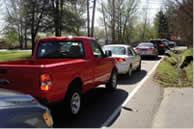FHWA Localized Bottleneck Reduction Program
Case Study
Printable Version [PDF 123KB]
You may need the Adobe® Reader® to view the PDF on this page.
Contact Information: Neil Spiller at Neil.Spiller@dot.gov
Arkansas
"Operation Bottleneck"
Metroplan MPO (Little Rock region) conducted surveys — online, at public meetings, and via ads in the local newspapers — to solicit public comments in 2009. Local media was enlisted to help promote the effort. Over 3,000 responses were received – in four weeks! Many responses validated already-planned projects. Some immediate actions were taken, such as foliage removed or cut back to improve sight distances, or missing or damaged signs were installed. In the short term, local governments will continue to use the information to:
- Consider new or additional traffic signage and signals
- Enhance signal coordination
- Support minor intersection improvements
- Improve access-conflict (i.e., access management) situations as opportunities present

Dave Ward Drive, Conway – "You have to stop at every traffic light between Hogan and I-40."
|

East Main & South Pine in Cabot – "Almost impossible to make a left turn or go straight from either direction on East Main Street."
|
Solutions
Staff aggregated, and then disseminated the information to the locally responsible agencies. In some cases, regionally cooperative tasks were undertaken (i.e., a consultant was tasked with reviewing more-complex traffic signal operations; corridor studies and/or spot-specific projects will be realized, etc.) in direct response to the most accessible complaints. In other cases, Operation Bottleneck will influence regional-level decisions on major widenings and other transportation investments in the longer-term future. Operation Bottleneck makes government actions more directly responsible to citizens by providing thousands of people a chance to let their voices be heard.
Lesson Learned
Public comment is invaluable in validating concerns and providing an outlet for the public to be heard. Action items confirm to the public that the agency is listening and can provide a response.